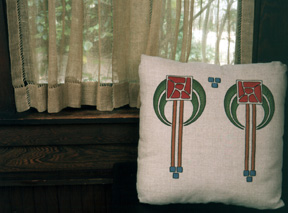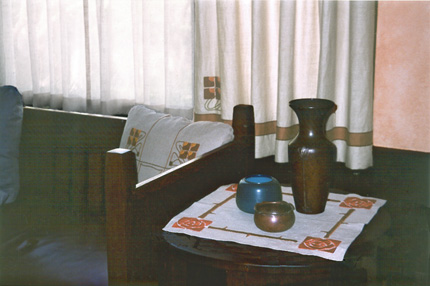
Curtains for Your Arts & Crafts Home
Curtain Basics •Fabric Choice•Mounting • Measuring
Curtains for your Arts & Crafts Home - Fabric Choice
The character of a fabric is largely determined by the fiber, the weight of threads and the closeness of weave. Linen, woven of fibers from the flax plant, is most typically used as it has the texture to harmonize in the Arts & Crafts style home.
An open weave "scrim" fabric will allow much light to pass through, while a more tightly woven fabric will provide privacy and insulation. The type of fabric also determines what type of design technique -- stencilling, embroidery, appliqué or hemstitching, may be applied.
Fabric type / Technique |
Stencilling |
Hemstitching |
Embroidery |
Applique |
| Scrim (a sheer open weave fabric) | yes see note |
yes |
running stitch designs |
no |
| Medium or Heavy weight fabrics | yes |
yes, for unlined panels |
yes, lining recommended |
yes, lining recommended |
We highly recommend lining for curtains with embroidery and applique designs. Lining will add additional opacity and insulation, protecting the decorative fabric from the sun, and give a uniform appearance of the curtains from the outside.
The choice of design, while sometimes dictated by existing patterns in the room, is largely a matter of personal taste. Also simple sheer hemstitched curtains are very much in keeping in the Arts & Crafts home. Stencilling is less expensive than a design with hand embroidery since less labor is required but is not of lesser quality, and in fact, is much more typical of what would have been found in many homes of the period.
With some exceptions, the same fabric should be used on all openings in a given room, although some windows may require two sets of curtains (scrims and overcurtains) while other openings in the same room may require only scrims - as on French doors; or only the overcurtains - as for small casement windows. Portières may be of a differnt fabric but each side should coordinate with the room it faces.
Generally, curtains in the Arts & Crafts style are not extremely full. We assume 1.5X fullness except for the sheerest of fabrics. In deciding the amount of fullness* consider:
- some fullness must be allowed, even if the curtains are to appear flat so not to leave a gap at the edges,
- curtains of a lighter weight fabric (scrims) may look better with more fullness: 2X or more, than those of a heavier fabric: generally 1.5X,
- the amount of light allowed in & visibility is effected by fullness,
- fuller curtains will require more stacking area at the sides of windows when open.
* The fullness refers to the amount of fabric that is gathered onto the rod. For example, for a rod 40" long , to achieve a 2 X fullness, the total width of the curtains when flat should be 80". This can be 2 panels of 40" each if you wish to have a pair which opens in the center.
Raw Linen Scrim curtains with Hand Hemstitching
Scrim fabrics give privacy during the day and filter sunlight.
Click here to see our Scrim Fabrics currently available.

Ecru Linen Scrim curtains and overcurtains of Flax Canvas with Checkerberry motif and hemband.
Click here to see our Medium and Heavy-weight Fabrics currently available.
Note: due to the open weave of scrim, stencil designs sometimes "disappear" when strong sunlight shines thru and become visable again durning night-time.